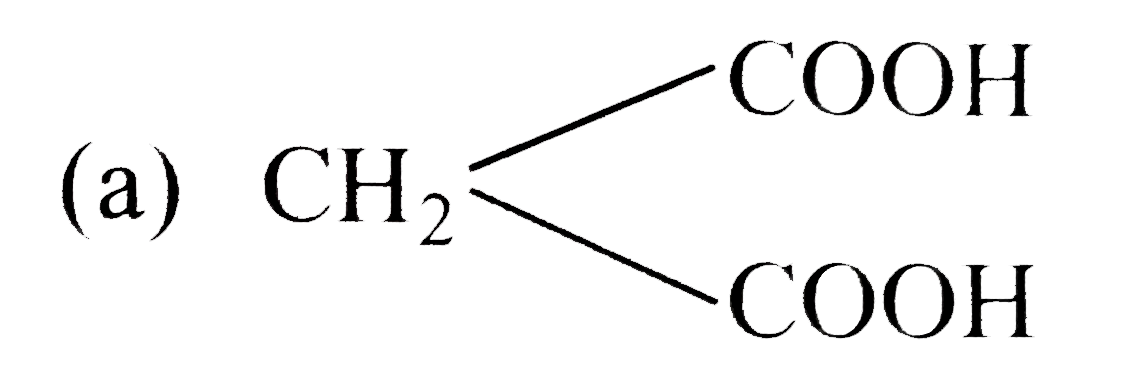Carboxylic acids having atleast one α-hydrogen react with Cl2orBr2 in the presence of phosphorus ( or a phosphorus halide) to give α-halo acids. This reaction is known as Hell-Volhard-Zelinsky reaction (HVZ reaction),
R−CH2COOHP/Br2−−−→ΔR−Br∣CH−COOH
The HVZ reaction is limited to the formation of α-chloro and a-bromo acids and it is sometimes awkward to carry out. The reagents ( X2 and P) are noxious and the reaction time is often long and the conditions of reaction are harsh.
R−CH2−CH2−OH→R−CH2−CH2−COOH
In above conversion, the reactant (A) follows the sequence of reactions with three reagents
PBr3,KCN,H+3O
PBr3,H+3O,KCN
HCN,PBr3,KCN
H+3O,KCN,PBr3
The correct Answer is:A
Step by step video, text & image solution for Carboxylic acids having atleast one alpha-hydrogen react with Cl_(2) or Br_(2) in the presence of phosphorus ( or a phosphorus halide) to give alpha-halo acids. This reaction is known as Hell-Volhard-Zelinsky reaction (HVZ reaction), R-CH_(2)COOHunderset(Delta)overset(P//Br_(2))toR-overset(Br)overset(|)"CH"-COOH The HVZ reaction is limited to the formation of alpha-chloro and a-bromo acids and it is sometimes awkward to carry out. The reagents ( X_(2) and P) are noxious and the reaction time is often long and the conditions of reaction are harsh. R- CH_(2)-CH_(2)-OHto R-CH_(2) -CH_(2) - COOH In above conversion, the reactant (A) follows the sequence of reactions with three reagents by Chemistry experts to help you in doubts & scoring excellent marks in Class 12 exams.
Topper's Solved these Questions
- BOOK - OP TANDONCHAPTER - CARBOXYLIC ACIDS AND THEIR DERIVATIVESEXERCISE - Integer4videos
CARBOXYLIC ACIDS AND THEIR DERIVATIVES
- BOOK - OP TANDONCHAPTER - CARBOXYLIC ACIDS AND THEIR DERIVATIVESEXERCISE - Brain storming problems30videos
CARBOXYLIC ACIDS AND THEIR DERIVATIVES
- BOOK - OP TANDONCHAPTER - BASIC PRINCIPLES OF ORGANIC COMPOUNDS (MECHANISM OF ORGANIC REACTIONS)EXERCISE - SINGLE INTEGER ANSWER TYPE QUESTIONS4videos
BASIC PRINCIPLES OF ORGANIC COMPOUNDS (MECHANISM OF ORGANIC REACTIONS)
- BOOK - OP TANDONCHAPTER - CHEMICAL KINETICSEXERCISE - LINKED COMPRESHENSION TYPE QUESTIONS ( SECTION-VI)4videos
CHEMICAL KINETICS
Similar Questions
Carboxylic acids having at least one α-hydrogen react with Cl2 or Br2 in the presence of phosphorous to give α-halo acids. The reaction is known as Hell -volhar-Zelinsky reaction (HVZ reaction).
R−CH2−COOHP/Br2−−−→ΔR−CH(Br)COOH
The HVZ reaction is limited to the formation of α-chloro and α-bromo acids and it is sometimes backward to carry out. the reagents (X2 and P) are noxious and the reaction time is often long and the conditions of reaction are harsh.
CH3−COOHBr2/P−−−→(A)NaCN−−−→(B)HOH/H+−−−−−−→(C)
The product (C) will beView SolutionCarboxylic acids having at least one α-hydrogen react with Cl2 or Br2 in the presence of phosphorous to give α-halo acids. The reaction is known as Hell -volhar-Zelinsky reaction (HVZ reaction).
R−CH2−COOHP/Br2−−−→ΔR−CH(Br)COOH
The HVZ reaction is limited to the formation of α-chloro and α-bromo acids and it is sometimes backward to carry out. the reagents (X2 and P) are noxious and the reaction time is often long and the conditions of reaction are harsh.
Which of the following will be obtained when acetic acid is subjected to HVZ reaction ?View Solution
Knowledge Check
- Question 1 - Select One
Carboxylic acids having atleast one α-hydrogen react with Cl2orBr2 in the presence of phosphorus ( or a phosphorus halide) to give α-halo acids. This reaction is known as Hell-Volhard-Zelinsky reaction (HVZ reaction),
R−CH2COOHP/Br2−−−→ΔR−Br∣CH−COOH
The HVZ reaction is limited to the formation of α-chloro and a-bromo acids and it is sometimes awkward to carry out. The reagents ( X2 and P) are noxious and the reaction time is often long and the conditions of reaction are harsh.
CH3CH2COOHRedP+Br2−−−−−−→(A)alc.KOHB. The product (B) is :A2-ketopropanoic acidBacrylic acidC2-hydroxypropanoic acidD2-aminopropanoic acid - Question 2 - Select One
Carboxylic acids having atleast one α-hydrogen react with Cl2orBr2 in the presence of phosphorus ( or a phosphorus halide) to give α-halo acids. This reaction is known as Hell-Volhard-Zelinsky reaction (HVZ reaction),
R−CH2COOHP/Br2−−−→ΔR−Br∣CH−COOH
The HVZ reaction is limited to the formation of α-chloro and a-bromo acids and it is sometimes awkward to carry out. The reagents ( X2 and P) are noxious and the reaction time is often long and the conditions of reaction are harsh.
CH3COOHBr2/RedP−−−−−−→(A)NaCN−−−→(B)HOH/H+−−−−−−→(C)
The product (C) will be:A B
B C
C D
D
- Question 3 - Select One
Carboxylic acids having at least one α-hydrogen react with Cl2 or Br2 in the presence of phosphorous to give α-halo acids. The reaction is known as Hell -volhar-Zelinsky reaction (HVZ reaction).
R−CH2−COOHP/Br2−−−→ΔR−CH(Br)COOH
The HVZ reaction is limited to the formation of α-chloro and α-bromo acids and it is sometimes backward to carry out. the reagents (X2 and P) are noxious and the reaction time is often long and the conditions of reaction are harsh.
Which of the following carboxylic acids will not give HVZ reaction ?ACH3−COOHBCH3−CH3∣CH−COOHCCH3−CH2−COOHDCH3−CH3∣C∣CH3−COOH
Carboxylic acids having at least one α-hydrogen react with Cl2 or Br2 in the presnence of red phosphorus to give α-halo acids. The reaction is known as H.V.Z. reaction. The HVZ reaction is limited to the formation of α-chloro acid and α-bromo acid and it is sometimes difficult to carry out the reaction. Answer the following questions :
Which of the following carboxylic acids will not give HVZ reaction ?View SolutionThe reaction RCH2CH2COOHRedP−−→Br2RCH2−C∣BrHCOOH is called as
View SolutionThe reaction
RCH2CH2COOHRedP−−→Br2
R−CH2−CH∣Br−COOH is called asView SolutionCH3CH2COOHBr2−−→red PABr2−−→B
What is B?View SolutionWhich of the following will not undergo Hell-Volhard Zelinsky (HVZ) reaction ?
View Solution

